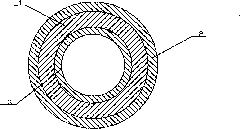Method for connecting resin-based composite material tube and metal material
A composite material tube and metal material technology, applied in the connection field of resin-based composite materials, can solve the problems of low shear strength, deformation of glue layer and bolts, weakening of the overall bearing capacity of the structure, etc. Good results
- Summary
- Abstract
- Description
- Claims
- Application Information
AI Technical Summary
Problems solved by technology
Method used
Image
Examples
Embodiment 1
[0021] Such as figure 2 , image 3 , Figure 4 and Figure 5 Shown:
[0022] First, a metal tube 3 with the same outer diameter as the inner diameter of the composite material tube 1 and higher rigidity is arranged inside the joint of the composite material tube 1 to improve the rigidity of the composite material tube 1; then, the outer surface of the composite material tube 1 and the metal sleeve respectively 2. Process the thread 4 that matches each other on the inner surface. Finally, when connecting the metal sleeve 2 to the composite material pipe 1, divide the metal sleeve 2 into several parts and thread the composite material pipe 1. In this example, three rings are used. The high-strength bolts 5 are distributed according to 120 degrees, and the metal sleeve 2 is connected as a whole, and the pre-tightening force is applied to the composite material pipe 1 by fastening the bolts to increase its bearing capacity. The metal material includes a metal pipe 3 and a met...
Embodiment 2
[0024] Such as figure 2 , image 3 and Figure 6 Shown:
[0025] The only difference from Example 1: the composite material pipe 1 and the metal sleeve 2 apply preload to the joint of the composite material pipe 1 through interference fit, rather than through the ring high-strength bolts, and R1 is the metal sleeve before the interference fit. The radius of the sleeve 2, R2 is the radius of the metal sleeve 2 after the interference fit.
[0026] The composite tube 1 also includes a composite rod.
PUM
 Login to View More
Login to View More Abstract
Description
Claims
Application Information
 Login to View More
Login to View More - R&D
- Intellectual Property
- Life Sciences
- Materials
- Tech Scout
- Unparalleled Data Quality
- Higher Quality Content
- 60% Fewer Hallucinations
Browse by: Latest US Patents, China's latest patents, Technical Efficacy Thesaurus, Application Domain, Technology Topic, Popular Technical Reports.
© 2025 PatSnap. All rights reserved.Legal|Privacy policy|Modern Slavery Act Transparency Statement|Sitemap|About US| Contact US: help@patsnap.com



